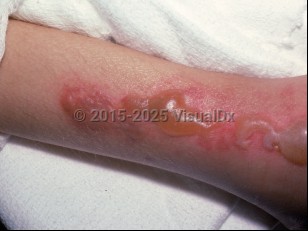Coma bullae in Child
Alerts and Notices
Important News & Links
Synopsis

They occur in comatose or immobile patients at points of maximum pressure and in patients with neurologic disorders. They form within 48-72 hours after the immobility. They can be skin colored or red / purple from hemorrhage. Coma bullae have been associated with barbiturate overdose.
Codes
L13.8 – Other specified bullous disorders
SNOMEDCT:
339008 – Blister
Look For
Subscription Required
Diagnostic Pearls
Subscription Required
Differential Diagnosis & Pitfalls

Subscription Required
Best Tests
Subscription Required
Management Pearls
Subscription Required
Therapy
Subscription Required
Drug Reaction Data
Subscription Required
References
Subscription Required

